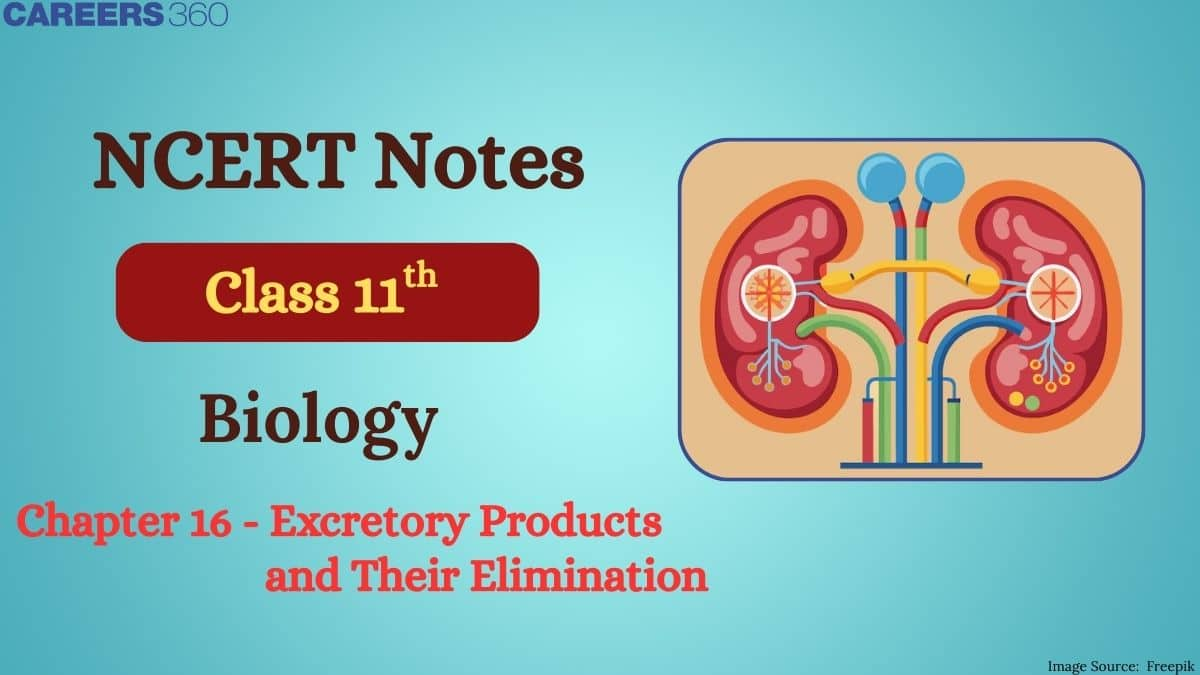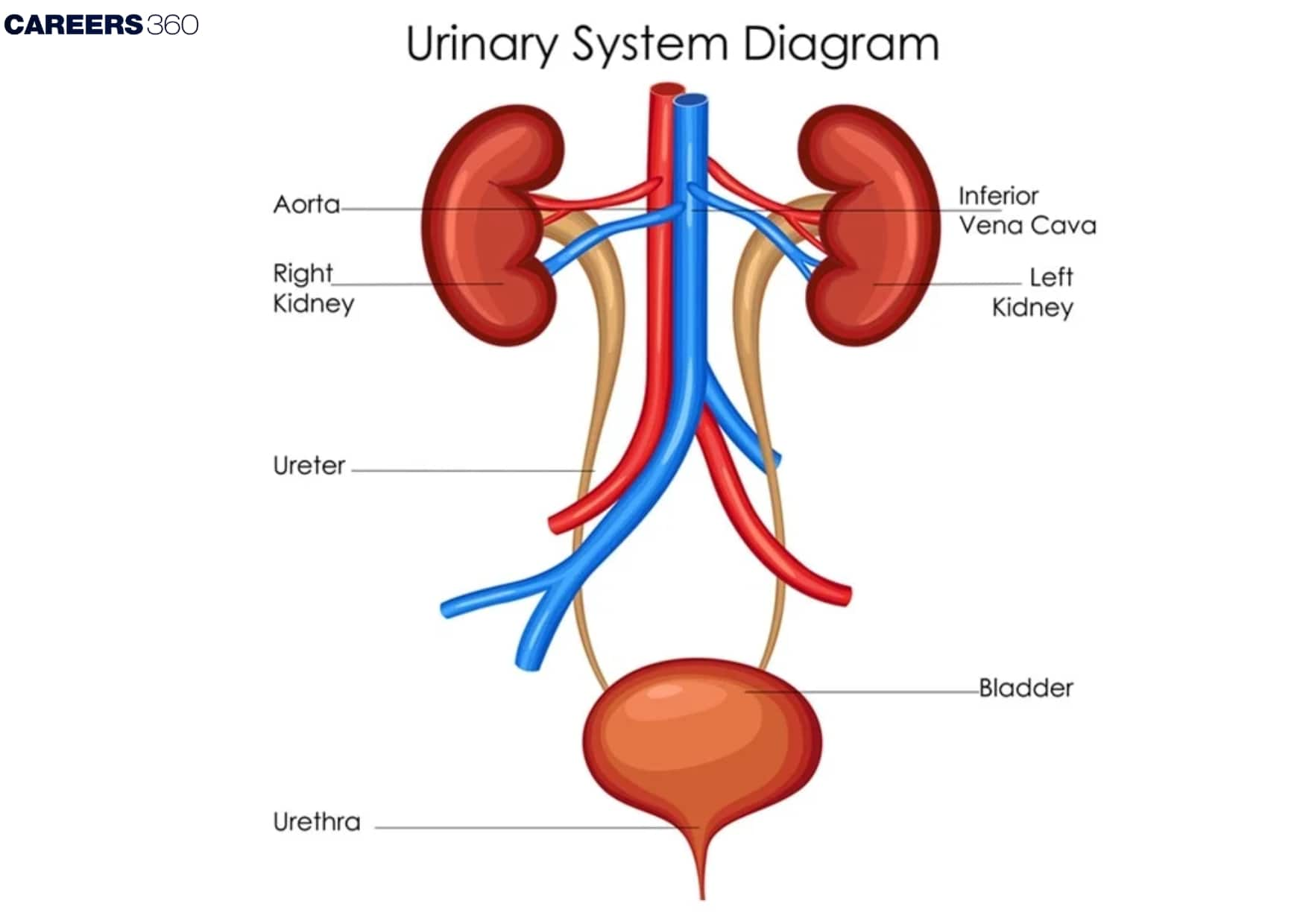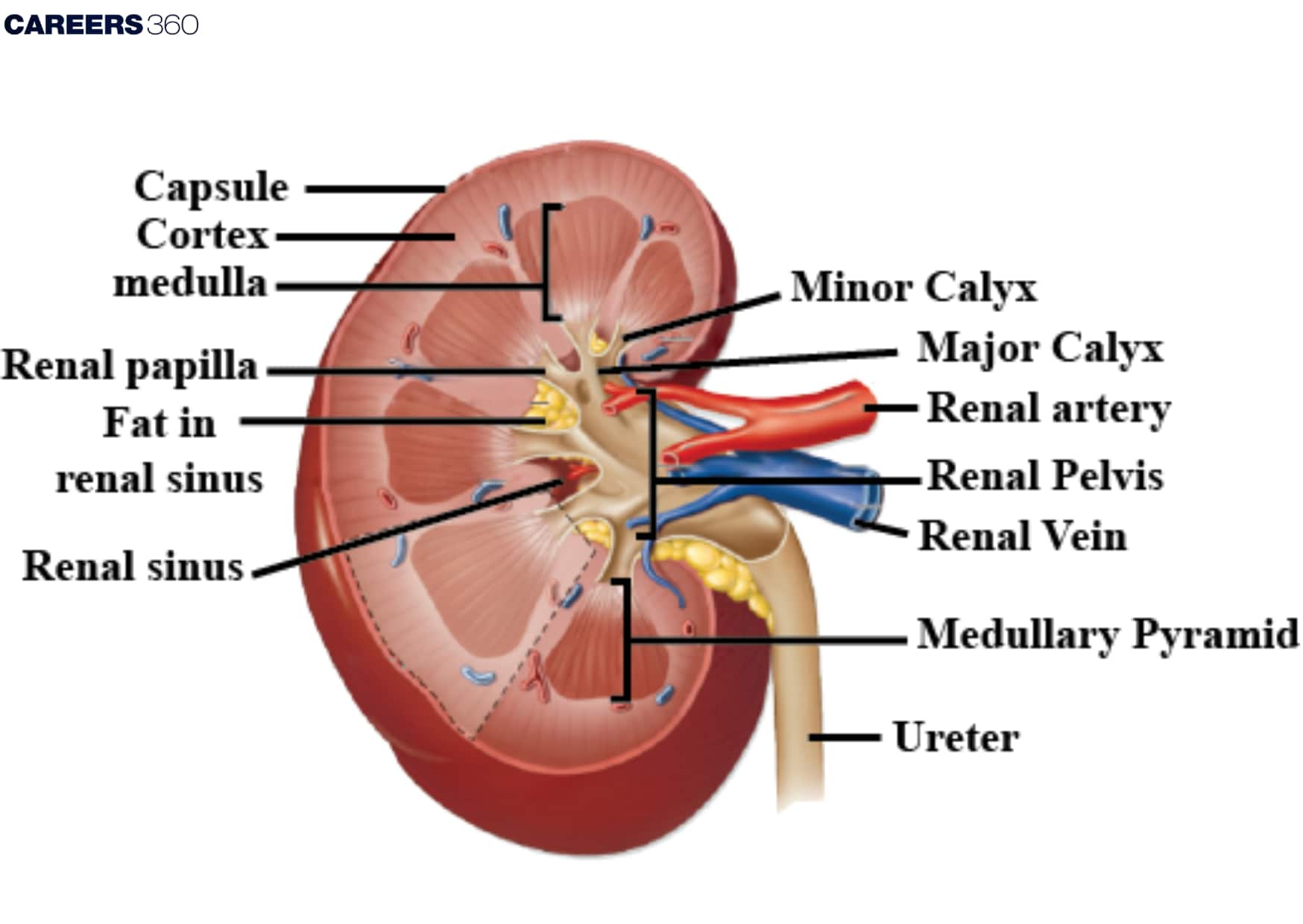NCERT Class 11 Biology Chapter 19 Notes Excretory Products And Their Elimination- Download PDF Notes
Have you ever wondered how the human body safely removes its waste products? The NCERT Class 11 Biology Chapter 16 Notes Excretory Products and Their Elimination explain topics simply. These notes provide short points, labelled diagrams, and solved examples so revision feels easy and stress-free. Topics like stages of urine formation, regulation of kidney functions, and the importance of maintaining osmotic balances are included. The NCERT Notes are also helpful for last-minute preparation before board exams or competitive exams like NEET.
This Story also Contains
- NCERT Class 11 Biology Chapter 16 Notes: Download PDF
- Class 11 Biology Chapter 16 Excretory Products And Their Elimination Notes
- Chapter 16 Biology: Previous Year Questions and Answers
- How to Use Excretory Products And Their Elimination Class 11 Notes Effectively?
- Advantages of Class 11 Biology Chapter 16 Excretory Products And Their Elimination Notes
- Chapter-Wise NCERT Class 11 Notes Biology

The Excretory Products and their Elimination Class 11 Notes covers nitrogenous waste products, the human excretory system, and the roles of kidneys and nephrons. All points are arranged in a step-by-step format in the NCERT Class 11 Biology Chapter 16 Notes PDF for easy revision. Students can strengthen their understanding and perform well in exams by using the NCERT Notes for Class 11. These notes build a strong base and allow students to connect concepts with other chapters.
NCERT Class 11 Biology Chapter 16 Notes: Download PDF
PDF makes studying easier by giving you quick access to all important points in one place. Students don’t have to flip through pages or carry heavy books, just open the file on your phone and start revising. That’s why many students prefer using the NCERT Class 11 Biology Chapter 16 Notes PDF.
Also, students can refer,
Class 11 Biology Chapter 16 Excretory Products And Their Elimination Notes
The Excretory Products and Their Elimination chapter explores how the human body gets rid of waste to stay healthy and balanced, the structure of the excretory system, and how our kidneys manage to filter blood. Excretory Products and their Elimination Class 11 Notes are prepared by subject experts, following the latest NCERT guidelines.
Types of Nitrogenous Wastes and Their Removal
Metabolic processes and overconsumption of substances contribute to the body's storage of waste products. The most familiar nitrogenous waste products discharged by animals are ammonia, urea, and uric acid. According to the type of nitrogenous waste they excrete, organisms are categorized into three groups:
- Ammonotelic animals: These animals expel ammonia, which is very toxic and needs a lot of water for removal. Example: Bony fishes, amphibians, and invertebrates in water.
- Ureotelic animals: These animals produce urea, which is less toxic and uses less water for removal. Examples: Mammals, amphibians, and cartilaginous fishes.
- Uricotelic animals: These animals expel uric acid, which is the least toxic and is removed with the least water loss. Examples: Birds, reptiles, and insects.
- Humans are ureotelic, i.e., they mainly excrete urea.
Human Excretory System
The human excretory system includes the following structures:
Kidneys: Reddish-brown, bean-shaped organs lying against the dorsal inner wall of the abdominal cavity. Each kidney measures approximately 10-12 cm in length, 5-7 cm in width, and weighs approximately 120-170 g.
Ureters: Tubes that carry urine from the kidneys to the urinary bladder.
Urinary bladder: A muscular sac that stores urine until its excretion.
Urethra: A tube that transports urine out of the body.

There are approximately one million nephrons in each kidney, which are the functional units of the kidney. Each nephron is made up of:
- Glomerulus: A capillary network where filtration takes place.
- Bowman's Capsule: A cup-like structure that surrounds the glomerulus.
- Renal Tubule: Divided further into:
- Proximal Convoluted Tubule (PCT): Reabsorbs vital nutrients, electrolytes, and water.
- Henle's loop: Responsible for urine concentration.
- Distal Convoluted Tubule (DCT): Regulates pH and ion balance.
- Collecting Duct: Collects and transports urine to the renal pelvis.

Urine Formation
Three processes are involved in the formation of urine:
- Glomerular Filtration: The pressure of blood forces plasma constituents (excluding proteins) into the Bowman's capsule, an ultrafiltration process.
- Tubular Reabsorption: Necessary nutrients and most of the filtrate (approximately 99%) are reabsorbed into the blood.
- Tubular Secretion: Other waste materials are secreted into the tubule for excretion.
The Glomerular Filtration Rate (GFR) is approximately 125 mL.min⁻¹, i.e., the kidneys filter 180 litres of fluid daily, and only 1.5 liters is excreted as urine.
Mechanism of Urine Concentration
The countercurrent mechanism is responsible for urine concentration. It includes:
- Henle's Loop: The descending limb is water-permeable, whereas the ascending limb actively reabsorbs NaCl, rendering the medullary interstitium very concentrated.
- Vasa Recta: Parallel blood vessels to Henle's loop that preserve the osmotic gradient.
Regulation of Kidney Function
Kidney function is regulated by hormonal feedback mechanisms, primarily through:
- Antidiuretic Hormone (ADH): Secreted from the hypothalamus to enhance water reabsorption in the collecting ducts.
- Renin-Angiotensin System: Stimulated by decreased blood pressure, which results in the release of angiotensin II, enhancing blood pressure and GFR.
- Atrial Natriuretic Factor (ANF): Released by the heart to lower blood pressure and lower GFR.
Micturition
Urine is retained in the urinary bladder and eliminated through the urethra by the mechanism of micturition, which is regulated by the micturition reflex.
- As the bladder fills, stretch receptors transmit signals to the central nervous system (CNS).
- The CNS initiates bladder muscle contractions and relaxation of the urethral sphincter, resulting in urine release.
- On average, an adult passes about 1–1.5 L of urine daily.
Role of Other Organs in Excretion
Other organs also play a role in excretion apart from the kidneys:
- Lungs: Release carbon dioxide (CO2) and water vapor.
- Liver: secretes bile pigments (bilirubin, biliverdin) and detoxifies drugs.
- Skin: Excretes sweat with water, salts, and traces of urea.
Disorders of the Excretory System
The human excretory system can face several disorders that affect its normal function. These conditions may disturb waste removal and harm overall health if left untreated. Here are some important disorders you should know about:
- Uremia: Elevated level of urea in the blood due to kidney impairment. It might need hemodialysis (artificial kidney) for its management.
- Kidney Failure (Renal Failure): Kidney dysfunction, usually calling for kidney transplantation.
- Renal Calculi (Kidney Stones): Deposition of salts such as oxalates within the kidneys.
- Glomerulonephritis: Glomerular inflammation, impairing filtration and causing the presence of blood or protein in the urine.
Also Read
Chapter 16 Biology: Previous Year Questions and Answers
Some of the questions that have come in past years from the chapter are given below. For quick reference to all the topics, students can refer to the NCERT Class 11 Biology Chapter 16 Notes Excretory Products and their Elimination.
Question 1. Which one of the following is also known as an antidiuretic hormone?
Option 1. Oxytocin
Option 2. Vasopressin
Option 3. Adrenaline
Option 4. Calcitonin
Answer :
The hypothalamus produces the peptide hormone vasopressin, sometimes referred to as antidiuretic hormone (ADH), which is secreted by the posterior pituitary gland. Its main function is to control blood pressure and the body's water balance. By increasing the permeability of the collecting ducts, vasopressin works on the kidneys to increase water reabsorption, which lowers urine production and conserves water. Overproduction of vasopressin leads to excessive water retention in the body.
Hence, the correct answer is option (2) Vasopressin
Question 2. We can produce concentrated/dilute urine. This is facilitated by a special mechanism. Identify the mechanism.
Option 1. Reabsorption from PCT
Option 2. Reabsorption from the collecting duct
Option 3. Reabsorption/secretion in DCT
Option 4. Counter-current mechanism in Henle loop/Vasa recta
Answer :
The two limbs of Henle's loop, as well as the vasa recta, witness countercurrents. When we move towards the descending limb, the concentration increases, whereas it is diluted as we move towards the ascending limb. This countercurrent mechanism in Henle's loop helps concentrate urine and conserve water, ensuring efficient reabsorption of water and electrolytes. The vasa recta, by maintaining a countercurrent flow, preserves the osmotic gradient in the renal medulla, aiding in the production of concentrated urine.
Hence, the correct answer is option (4) Counter-current mechanism in Henle's loop/Vasa recta.
Question 3. Which one of the following statements is incorrect?
Option 1. The medullary zone of the kidney is divided into a few conical masses called medullary pyramids projecting into the calyces.
Option 2. Inside the kidney, the cortical region extends between the medullary pyramids as the renal pelvis
Option 3. The Glomerulus, along with Bowman's capsule, is called the renal corpuscle
Option 4. Renal corpuscle, proximal convoluted tubule (PCT), and distal convoluted tubule (DCT) of the nephron are situated in the cortical region of the kidney
Answer :
The cortical region does not extend as far as the renal pelvis between the medullary pyramids. Instead, the cortical tissue extends between medullary pyramids as columns of Bertini (renal columns), while the renal pelvis is a funnel-shaped structure that collects urine and channels it to the ureter. Therefore, that statement is incorrect because the cortical tissue extends between the medullary pyramids as renal columns (columns of Bertini), not as the renal pelvis.
Hence, the correct answer is option (2). Inside the kidney, the cortical region extends between the medullary pyramids as the renal pelvis
Question 4. Uricotelic organisms mainly excrete
Option 1. Ammonia
Option 2. Urea
Option 3. Uric acid
Option 4. Creatinine
Answer:
Uricotelic animals, such as birds, reptiles, and insects, excrete uric acid as their primary nitrogenous waste. Uric acid is the least toxic and requires very little water for excretion, helping these organisms conserve water efficiently.
Hence, the correct answer is option (3) Uric acid
Question 5. The part of the nephron that is impermeable to water is
Option 1. Proximal convoluted tubule (PCT)
Option 2. Collecting duct
Option 3. Descending limb of Henle’s loop
Option 4. Ascending limb of Henle’s loop
Answer:
The ascending limb of Henle’s loop is impermeable to water. It actively transports ions out into the medullary interstitium but does not allow water to follow, helping create the osmotic gradient necessary for urine concentration.
Hence, the correct answer is option (4), the ascending limb of Henle’s loop.
Also Read:
How to Use Excretory Products And Their Elimination Class 11 Notes Effectively?
The excretory system plays an important role in removing harmful wastes from the body and maintaining homeostasis. Well-structured notes can make learning this complex process much easier and help in clear revision.
Focus on diagrams like the nephron structure and urine formation steps, as they make understanding faster and easier.
Use Class 11 Biology Chapter 16 Excretory Products And Their Elimination Notes PDF to revise the mechanisms of osmoregulation and nitrogenous waste elimination in different organisms.
Important terms and flowcharts are highlighted in the NCERT Class 11 Biology Notes to improve learning before exams.
Compare examples of excretory products in animals and humans through the Class 11 Biology Chapter 16 Excretory Products and Their Elimination Notes.
Practice previous year questions along with the notes to improve application-based understanding.
Advantages of Class 11 Biology Chapter 16 Excretory Products And Their Elimination Notes
How the human body removes metabolic wastes and maintains the balance is explained in the Excretory Products and Their Elimination chapter. Well-organised notes make it easier for students to understand the structure and function of the excretory system /
- Class 11 Biology Chapter 16 Excretory Products And Their Elimination Notes PDF provides a clear explanation of the formation of urine and the role of the nephron in this process.
- Important topics like osmoregulation, nitrogenous wastes, and different types of excretory products are summarised in the notes.
- Students can save a lot of time during exams by studying through the notes, as everything is explained in a well-understandable manner.
- Diagrams included in the notes improve visual memory and better retention of the concepts.
- Students regularly studying from the notes will increase their knowledge and gain confidence to perform well in both school and competitive exams like NEET.
Chapter-Wise NCERT Class 11 Notes Biology
Students can refer to the table below, which provides well-structured notes for every chapter of Class 11 Biology for effective revision.
Frequently Asked Questions (FAQs)
Humans excrete nitrogenous wastes like urea, uric acid, and creatinine, along with water, salts, and carbon dioxide, as included in the NCERT Class 11 Biology Chapter 16 Notes Excretory Products and Their Elimination. These waste products are removed through urine, sweat, and exhalation to maintain homeostasis.
Kidneys filter blood, remove metabolic wastes, and regulate water and electrolyte balance. They form urine by filtering out toxins and excess substances, which are then excreted through the ureters, bladder, and urethra.
A nephron consists of the glomerulus, Bowman’s capsule, tubules, and loop of Henle. It filters blood, reabsorbs essential nutrients, and secretes waste into the urine, playing a key role in maintaining water and ion balance. A detailed explanation is provided in the NCERT Class 11 Biology Chapter 16 Notes Excretory Products and Their Elimination.
Animals excrete waste via different modes: ammonotelism (ammonia – fish, amphibians), ureotelism (urea – mammals, amphibians), and uricotelism (uric acid – birds, reptiles). These modes depend on water availability and metabolic needs.
The liver detoxifies harmful substances, breaks down hemoglobin into bilirubin, converts ammonia to urea, and metabolizes drugs and toxins. It also regulates cholesterol, hormone levels, and bile production for fat digestion.
Urea is formed in the liver through the urea cycle (ornithine cycle) by converting toxic ammonia and carbon dioxide into urea, which is then transported to the kidneys for excretion via urine.
Ammonia: Highly toxic, requires large water amounts for excretion (e.g., fish).
Urea: Less toxic, soluble, excreted by mammals.
Uric Acid: Insoluble, excreted as a paste to conserve water (e.g., birds, reptiles).
Osmoregulation maintains water and ion balance in the body, ensuring proper cellular function. It helps regulate blood pressure, prevents dehydration or overhydration, and supports metabolic homeostasis.
Courses After 12th
Applications for Admissions are open.
As per latest syllabus. Physics formulas, equations, & laws of class 11 & 12th chapters
JEE Main Important Chemistry formulas
Get nowAs per latest syllabus. Chemistry formulas, equations, & laws of class 11 & 12th chapters
JEE Main high scoring chapters and topics
Get nowAs per latest 2024 syllabus. Study 40% syllabus and score upto 100% marks in JEE
JEE Main Important Mathematics Formulas
Get nowAs per latest syllabus. Maths formulas, equations, & theorems of class 11 & 12th chapters
